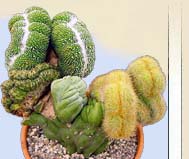Indoor
Floriculture

Leafy succulents
by Peter Lapshin

Cacti Library
'Cultivar' (V.Kalishev)

Moscow
Succulent Society

Moscow Indoor
Plant Club

Travels, nature,
botanical gardens

About Episcia
(Gesneriaceae)
 |
 |
CULTIVAR / КУЛЬТИВАР e-Magazine about exotic forms of Cactaceae ENGLISH / RUS-(Win1251) | |||
|
|
|

|
Yaroslav Prohazka, Chechia
Golden time, when one could go to America and dig for his collection of cacti, in the past. Today you will allow to take away with them only impressions and film. For the plant boundary to the castle. Therefore, written and published here in 1993, the paper - a story. The expedition for the cactus to Argentina, I went with three of their comrades from Austria. Two of them have already visited there twice. It should be noted that in the way they prepared for the conscience. Beforehand, we agreed that the time will be given subgenus Ovatisemineum Schulz: Gymnocalycium gibbosum, G. striglianum and G. borthii. In addition, we plan how to penetrate deeper into Patagonia, in order to identify the most southern areas and Gymnocalycium cacti at all.  So 14 hours of flight from Rome to Buenos Aires over. In the capital of Argentina to take a car and performs a throw on the three kilometer south to town of Azul. Already on the second day of our stay in America, found in two locations, a new form of G. schroederianum ssp. bayense. Slowly collect cacti in mountainous terrain Sierra Tandtii, in the vicinity of Balcarce, and then in the mountains of Sierra Chata, Sierra Barrosa on the outskirts of towns Balcarce, Cerro Moro, Cinco Cerros, Sierra Bachica, Sierra Virgilancia, Sierra de los Padres. Everywhere in these places made available various forms of G. hyptiacantum. Town on the outskirts of Buenos Aires - a typical «Pampa» - flat, fertile soil, covered with grass and sparse bushes. There are some mountainous areas with elevations up to a height of 250-300 meters. Flat tops of the mountains, like the surface of the board. It is here and growing middle Gymnocalycium islets loessial sediment. The way they are not easy, as many passes through the vertical cliffs, and requires good physical preparation.  It is sent to the Mar del Plata. And then further along the shores of the ocean to the west to the mountains Sierra de la Tunas and Sierra de la Ventana. There are already other mountains rise to 1000-1200 meters. To the north of Sierra de la Ventana begins next mountain - Sierra de Cura Malal. Focusing on Sierra de la Ventana, as it is here once collected G. gibbosum, cacti, low yielding layer, A. Fritsch (photo 3). And we indeed have found - in the mountains of Sierra de la Tunas. It seems that it was G. gibbosum v. Caespitosum (photo 4), but definitely will not argue long. The point is that certain plants growing in this region is very problematic. One exactly what it is G. gibbosum. In these places to collect his P94 and J. Pitz.  Because of rain, we decide to charge reduce the duration of our stay in this place and go to the area of Bahia Blanca, Rio Colorado and along the Rio Negro to the Carmen de Patagonas. Along the banks of the river in the bush in the shade of shrubs find excellent copies of cacti, which can not immediately identify, and attribute a while to G. sp. Rio Negro. Big surprise us presents township Carmen de Patagonas. More Fritsch wrote that civilization is destroying the cacti. But today you can find quite a solid amount of fine-looking Gymnocalycium, growing right in the sand. These cacti, I have identified as G. gibbosum typ.  Photos :
|
| Cultivar e-magazin: Copyright (c) by Valery Kalishev, Chelyabinsk, Russia, since 2000. Design and hosting by Peter Lapshin, since 2002. Contacts: Peter Lapshin |
|
|